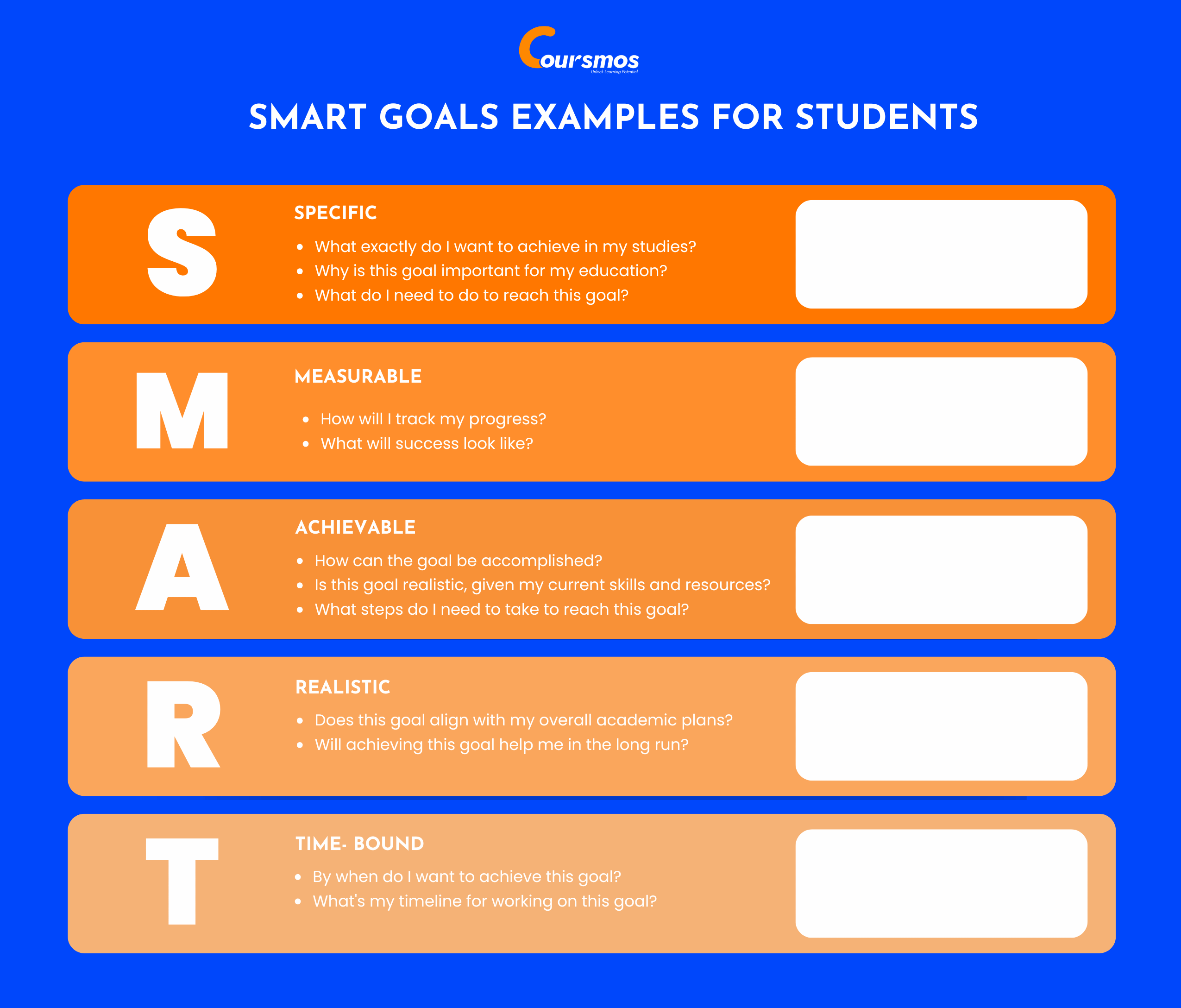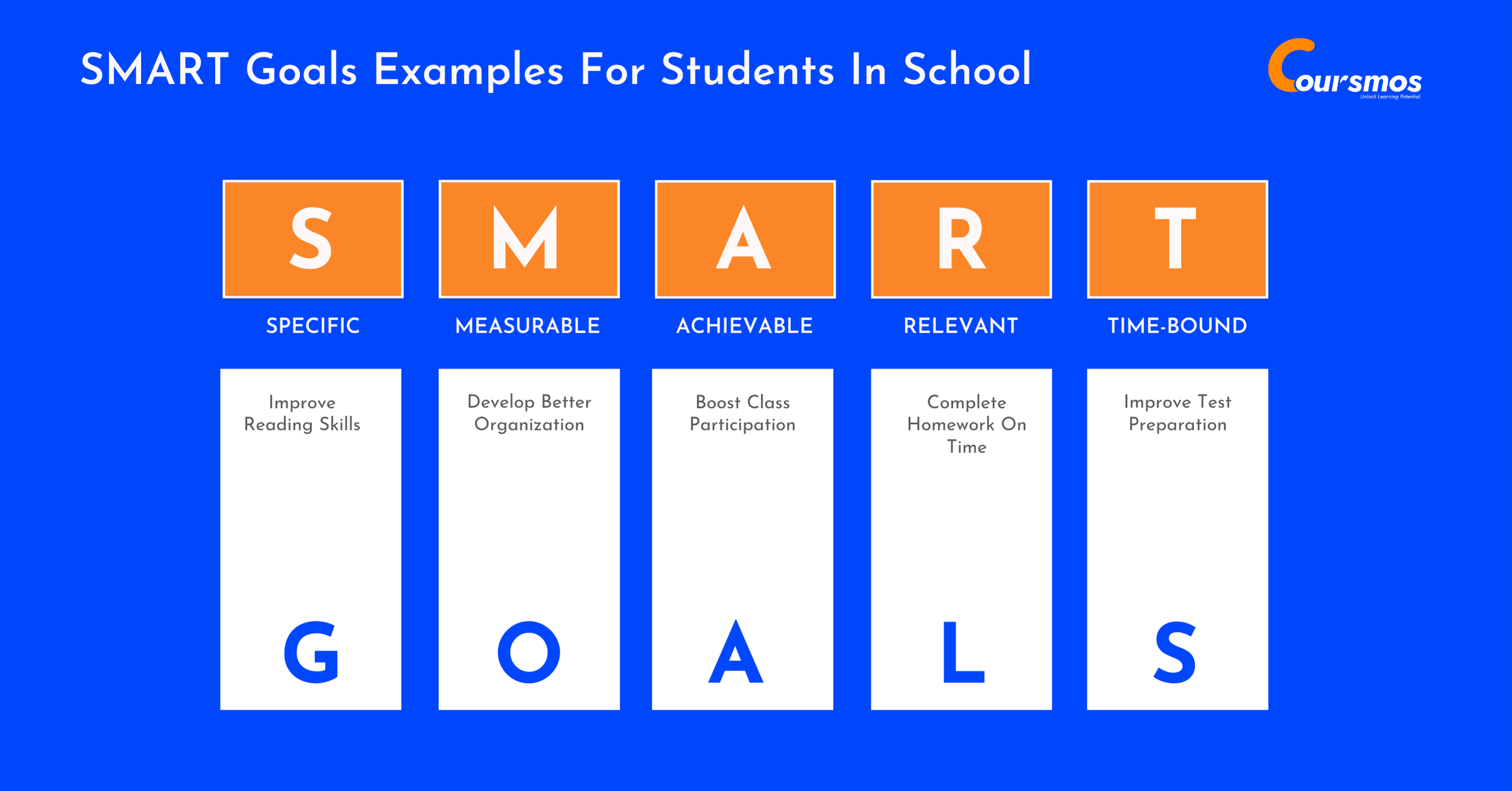As someone who has worked on countless projects, I’ve witnessed firsthand how setting clear, actionable goals can transform academic performance. When I was in college, I struggled with managing my time effectively until a professor introduced me to SMART goals.
This approach completely changed how I approached my studies and later helped me guide students toward achieving their own academic success.
SMART goals provide structure and clarity, making it easier for students to focus their efforts and measure their progress.
Whether you’re aiming to improve your GPA, develop better study habits, or prepare for your future career, having a systematic approach to goal-setting can make all the difference. By the end of this article, we have provided a template to help you get started.
What Are The 5 SMART Goals For Students?
Setting effective goals requires more than just stating what you want to achieve. The SMART framework breaks down goal-setting into five essential components that work together to create clear, actionable objectives.
The SMART acronym stands for:
- Specific: Your goal should be clear and well-defined, answering questions like what exactly needs to be accomplished, who’s responsible, and what steps are needed.
- Measurable: You need concrete criteria to track your progress and know when you’ve achieved your goal. Without measurement, it’s difficult to know if you’re making progress.
- Achievable: While goals should stretch your abilities, they shouldn’t be impossible to reach. An achievable goal is one that’s realistic, given your current circumstances.
- Relevant: Your goal should matter to you and align with your broader objectives. Ask yourself if this goal will help you get where you ultimately want to go.
- Time-bound: Every goal needs a target date or deadline to create a sense of urgency and prevent procrastination.
I’ve seen remarkable transformations when students apply this framework. One student I worked with went from consistently missing assignment deadlines to completing work ahead of schedule simply by setting specific, time-bound goals for each week.
What Is An Example Of A SMART Goal?

Let’s look at a common student goal and transform it into a SMART goal to see how the framework works in practice.
A general goal might be: “I want to do better in school.”
Turning this into a SMART goal:
“I will improve my current B- average in Math 101 to at least a B+ by the end of this semester by completing all homework assignments on time, attending weekly tutoring sessions, and dedicating 30 minutes daily to practice problems.”
Let’s break this down:
- Specific: The goal targets a particular class (Math 101) and specifies actions (completing homework, attending tutoring, daily practice).
- Measurable: Success means achieving at least a B+ grade, which can be tracked through assignments and tests.
- Achievable: Going from a B- to a B+ is challenging but realistic with the right effort.
- Relevant: Improving in math aligns with broader academic success.
- Time-bound: There’s a clear deadline—the end of the semester.
When I implemented a similar goal for my biology course in college, I not only achieved my target grade but also developed study habits that benefited me throughout my academic career.
SMART Goals Examples For Students In School
Elementary and high school students can benefit tremendously from learning to set SMART goals early in their education. Here are some effective examples I’ve seen work well:
1. Improve Reading Skills
“I will improve my reading comprehension by reading 20 pages of grade-appropriate books every day after school for the next 3 months, keeping a reading journal to summarize key points, and discussing what I’ve read with my parents twice weekly.”
2. Develop A Better Organization
“I will organize my study space and maintain it by spending 15 minutes each Sunday sorting through papers, updating my planner with upcoming assignments, and preparing materials for the week ahead for the entire school year.”
3. Boost Class Participation
“I will participate more actively in class discussions by raising my hand to answer or ask at least three questions each day for the next month, preparing for class by reviewing notes the night before, and sitting in the front row to minimize distractions.”
4. Complete Homework On Time
“I will complete all homework assignments on time for the next 6 weeks by setting aside 90 minutes of focused study time each weekday evening from 7-8:30 PM, working in a quiet space without phone distractions, and checking off assignments in my planner as they’re completed.”
5. Improve Test Preparation
“I will improve my science test scores from a C average to a B or higher by creating detailed study guides one week before each test, forming a study group that meets twice before the test, and reviewing material for 20 minutes each day leading up to the exam.”

Most students graduate high school when they are 17 to 18 years old, but the journey to that milestone varies greatly from student to student.
I’ve seen students transform their academic performance with goals like these. In fact, setting clear academic goals can be the difference between constant stress and steady progress. One high school sophomore I worked with struggled with procrastination until she created a specific homework completion goal with daily benchmarks. Within weeks, her stress levels decreased significantly, and her grades improved across all subjects.
SMART Goals Examples For Students In College
College presents unique challenges and opportunities for goal setting. The independence of college life requires more self-discipline, making SMART goals even more valuable.
Here are examples that have proven effective for college students:
1. Maintain A Strong GPA
“I will maintain a GPA of at least 3.5 this semester by attending all classes, completing readings before lectures, visiting professors’ office hours at least once for each course, and forming study groups for my most challenging classes.”
2. Build Professional Connections
“I will expand my professional network by attending three industry networking events this semester, connecting with at least five professionals on LinkedIn after each event, and scheduling two informational interviews per month with people working in my target field.”
3. Balance Academics and Social Life
“I will create a healthy school-life balance by designating specific times for studying (25 hours weekly) and social activities (10 hours weekly), using a digital calendar to schedule both, and evaluating this balance at the end of each week for the entire semester.”
4. Manage College Finances
“I will improve my financial management by creating a monthly budget that tracks all expenses, reducing discretionary spending by 15%, saving $50 per month, and reviewing my financial status every Sunday evening for the next 6 months.”
5. Gain Practical Experience
“I will enhance my resume by securing an internship in my field by March 15th, by researching and applying to at least two opportunities weekly, updating my resume and cover letter for each application, and practicing interview skills with the career center.”
During my junior year of college, I created a networking goal similar to example #2. By consistently attending events and following up with professionals, I secured three interviews that ultimately led to my first job offer before graduation. The structured approach made networking less intimidating and much more effective.
How To Create SMART Goals For Students?
Creating effective SMART goals requires thoughtful consideration and planning.
Here’s a step-by-step process I’ve refined through years of working with students:
1. Identify Your Core Objective
Start by identifying what you genuinely want to achieve. Ask yourself: What area of my academic or personal life do I want to improve? Is this something I’m motivated to work toward?
2. Make It Specific
Once you’ve identified your objective, make it as specific as possible by answering:
- What exactly do I want to accomplish?
- Why is this important to me?
- Who needs to be involved?
- What resources or limitations are involved?
- Where will this happen?
3. Establish Measurement Criteria
Determine how you’ll track progress and know when you’ve achieved your goal:
- How many/much?
- How will I know when it’s accomplished?
- What data will I use to measure progress?
4. Ensure It’s Achievable
Assess whether your goal is realistic given your current circumstances:
- Do I have the necessary resources and capabilities?
- Have others successfully achieved this before?
- Is this goal reasonable considering my current workload and responsibilities?
5. Check Relevance
Make sure your goal aligns with your broader objectives:
- Why am I setting this goal now?
- Is it aligned with my long-term academic or career goals?
- Is this the right time to pursue this goal?
6. Set A Timeline
Establish deadlines that create urgency but remain realistic:
- When will I achieve this goal?
- What’s my deadline?
- What are the milestone dates for tracking progress?
7. Write It Down
Document your SMART goal in a complete sentence or paragraph that incorporates all elements.
I’ve helped many students develop SMART goals using this process. One memorable case involved a freshman struggling with time management. We created a specific goal around daily planning that included exactly how much time to allocate to different subjects, when to study, and where. Within three weeks, he reported feeling significantly less overwhelmed and more in control of his academic life.
What To Do After Creating Your SMART Goals
Creating your goals is just the beginning. The real work lies in implementing and maintaining momentum toward achieving them.
Here’s what I recommend based on both personal experience and what I’ve seen work for students:
1. Create an Action Plan
Break down your SMART goal into smaller, actionable steps. For each step, identify what resources you’ll need and any potential obstacles you might face. I’ve found that having a visual roadmap makes the goal feel more tangible and less overwhelming.
2. Set Up a Tracking System
Establish a system to monitor your progress. This could be a journal, a spreadsheet, a habit-tracking app, or regular check-ins with an accountability partner. I personally use a weekly review system where I assess what worked, what didn’t, and what adjustments I need to make.
3. Schedule Regular Review Times
Set specific times to review your progress—weekly, bi-weekly, or monthly depending on your goal’s timeframe. During these reviews, honestly assess your progress and make adjustments as necessary.
4. Share Your Goals
Tell someone about your goals—a friend, family member, advisor, or mentor. When I was working on improving my public speaking skills in college, I shared my goals with my roommate, who then regularly asked about my progress, which helped keep me accountable.
5. Celebrate Milestones
Acknowledge and celebrate when you reach significant milestones. Recognition of progress, even small wins, provides motivation to continue. When I completed my first successful presentation after weeks of practice, I treated myself to a nice dinner as a reward.
6. Adjust When Necessary
Be flexible and willing to adjust your goals if circumstances change or if you discover your original goal needs refinement. This isn’t giving up—it’s being responsive to reality.
How To Measure Your Progress Toward SMART Goals
Measuring progress is crucial for maintaining motivation and ensuring you’re on track to achieve your goals. Here are effective strategies I’ve used and recommended to students:
1. Use Visual Trackers
Visual representations of progress can be powerful motivators. Consider using:
- Progress bars for long-term goals
- Checklists for daily or weekly tasks
- Charts or graphs that show improvement over time
I’ve had students create colorful wall charts where they could see their reading time increasing or their test scores improving over the semester.
2. Keep a Goal Journal
Maintain a dedicated journal where you record activities related to your goal, reflections on your progress, and any insights or challenges you encounter. This creates a record you can review to see how far you’ve come.
3. Set Regular Check-in Points
Establish specific dates to formally review your progress. During these check-ins, ask yourself:
- Am I making the progress I expected?
- What’s working well?
- What obstacles am I facing?
- Do I need to adjust my approach or timeline?
4. Get External Feedback
Sometimes it’s difficult to objectively assess your own progress. Ask for feedback from teachers, peers, or mentors who can provide valuable perspective on how you’re doing.
One of my students was working on improving her writing skills. She arranged bi-weekly meetings with her English professor to review her work and get feedback on her progress, which provided both accountability and expert guidance.
5. Use Technology Tools
Take advantage of apps and digital tools designed for goal tracking. Options include:
- To-do list apps like Todoist or Microsoft To Do
- Habit trackers like Habitica or Streaks
- Project management tools like Trello or Asana
6. Create a Scoreboard
For goals with numerical targets, create a scoreboard or tracking system where you can record your performance. Seeing the numbers improve over time can be highly motivating.
When I was working to improve my typing speed in college, I tested myself weekly and tracked my words per minute. Watching that number increase from 45 to over 80 WPM over a semester was incredibly satisfying and kept me practicing consistently.
Here is a template to help you track your progress:
✨ Use this template to set goals, track improvements, and stay motivated on your journey! 🚀
Related Reads:
Conclusion: SMART Goals Help In Setting The Path To Success
SMART goals have transformed my approach to achievement and the success of countless students I’ve worked with. By creating goals that are Specific, Measurable, Achievable, Relevant, and Time-bound, you’re not just wishing for success—you’re creating a roadmap to get there.
Remember that the process matters as much as the destination. Each step you take toward your SMART goals builds valuable skills in planning, self-discipline, and resilience that will serve you throughout your academic journey and beyond.
Start small, stay consistent, and celebrate your progress along the way. Your future self will thank you for the foundation you’re building today.
FAQs
I recommend students review their SMART goals at least monthly, but make more comprehensive revisions at natural transition points like the beginning of a new semester or academic year.
Absolutely. In fact, I’ve found SMART goals particularly beneficial for students with learning disabilities because they provide clear structure and break larger objectives into manageable steps.
Parent involvement can be valuable for younger students who are still developing goal-setting skills. I recommend a collaborative approach where parents guide the process but ensure the goals reflect the student’s own interests and priorities.
Traditional resolutions often lack the specificity, measurement criteria, and realistic timelines that make SMART goals effective.
Setting too many SMART goals can be counterproductive. I’ve seen students become overwhelmed when trying to pursue too many goals simultaneously. I typically recommend focusing on 2-3 SMART goals at a time, especially when first learning the process.







